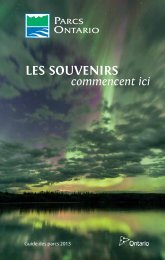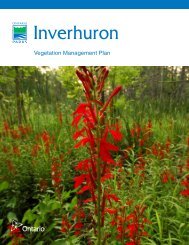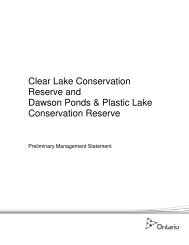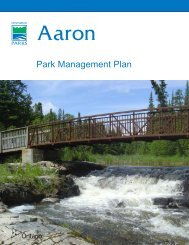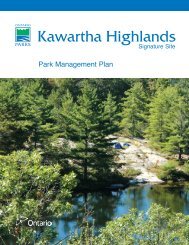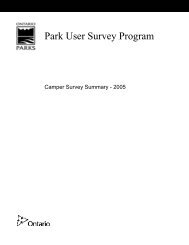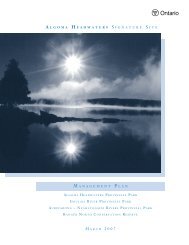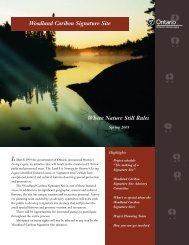Sandbanks Draft Veg Mgmt Plan - Ontario Parks
Sandbanks Draft Veg Mgmt Plan - Ontario Parks
Sandbanks Draft Veg Mgmt Plan - Ontario Parks
Create successful ePaper yourself
Turn your PDF publications into a flip-book with our unique Google optimized e-Paper software.
APPENDIX E – Invasive Species Information Sheets<br />
Common Buckthorn Rhamnus cathartica L.<br />
Glossy Buckthorn<br />
Rhamnus frangula<br />
Buckthorn Family<br />
Rhamnaceae<br />
Alternate Common Name<br />
European Buckthorn<br />
Distribution<br />
Native to most of Europe, and west and north Asia.<br />
In <strong>Ontario</strong>, Buckthorn is found east and south west of the Canadian Shield.<br />
In SEZ, Buckthorn is known to occur in Peter’s Woods, Fitzroy, <strong>Sandbanks</strong>, Presqu’ile,<br />
Darlington, Voyageur, Charleston Lake, Murphys Point, Burntlands, Emily, and Menzel.<br />
Biology and Ecology<br />
Brackets indicate Glossy Buckthorn features where they differ from Common Buckthorn.<br />
General Description: Shrub or small tree, up to 6 m in height. Branches spine tipped (No<br />
spine). Branchlets are stout and purplish-red or grey-brown (brown to gray with pale<br />
lenticels). Leaves persist throughout the winter.<br />
Leaves: Leaves up to 8 cm long and 4 cm wide, and generally opposite, but can be subopposite<br />
or alternate. Elliptic to ovate leaves have a shiny appearance and fold slightly<br />
along the midrib near the tip (Do not fold). Strongly curved veins. Leaf margin toothed. (Leaf<br />
margins wavy).<br />
Flowers: Less than 6 mm in diameter, greenish yellow. Found in dense clusters in the leaf<br />
axils. Early June.<br />
Fruit: Three – four seeds in a berry-like drupe. Clustered fruit turns black when ripe in<br />
August or September.<br />
Similar species: The native Buckthorn, Alder-leaved Buckthorn (Rhamnus alnifolia), has<br />
much narrower leaves, has no thorns, and, as the name implies, looks more like an alder<br />
species.<br />
Habitat: Common Buckthorn found in dry to moist habitats, especially open areas and<br />
successional forests (Soper and Heimburger, 1982). Glossy Buckthorn prefers wetter and<br />
more acidic soils. Buckthorn does not do well in deep shade, and colonies are often evenaged,<br />
as seedlings cannot grow under shade of mature plants.<br />
Dispersal: Dispersed by birds, mice and possibly by members of the deer family. Seed may<br />
also be water dispersed, as the dry fruit of Common Buckthorn can float for 6 days and seed<br />
for 3 days before sinking, while the fresh fruit of Glossy Buckthorn can float for 19 days, and<br />
dry seeds for one week (Converse, 1984). This is significant for populations found along<br />
waterways, or areas that are seasonally flooded (Converse, 1984).<br />
Potential Threats to Native Flora and Fauna<br />
<strong>Sandbanks</strong> <strong>Veg</strong>etation Management <strong>Plan</strong> A-14<br />
<strong>Ontario</strong> <strong>Parks</strong>, SE Zone<br />
2009



